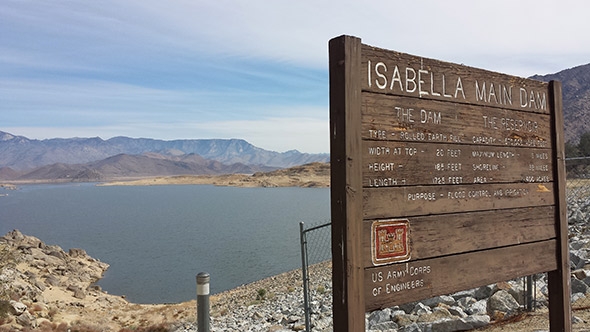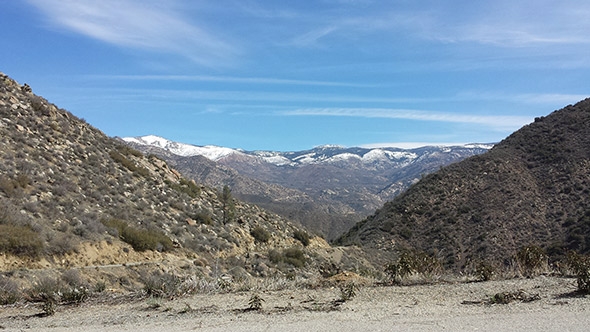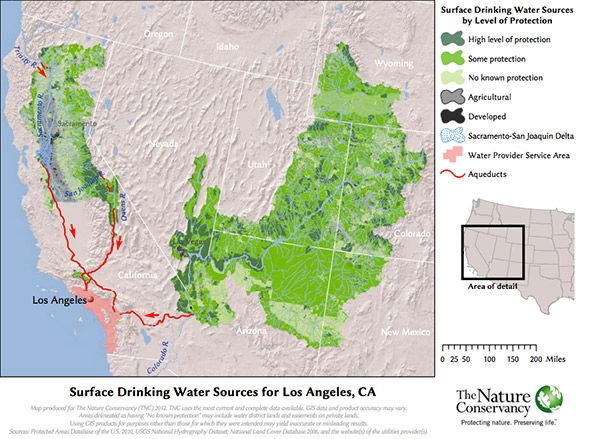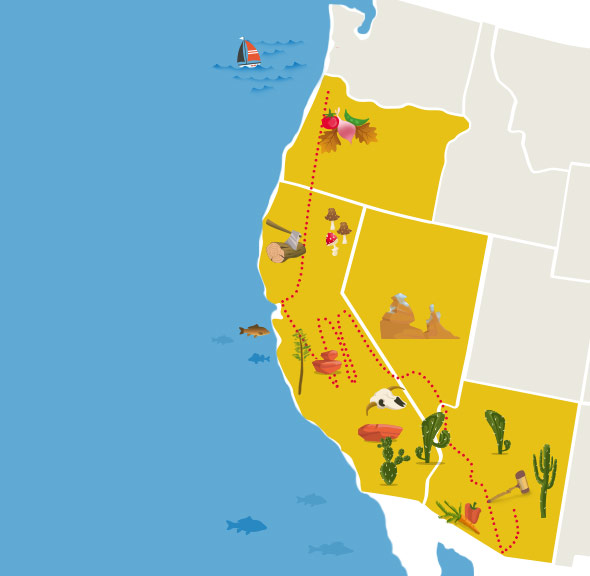The Thirsty West: Where’s the Snow?
The mild California winter will exacerbate the terrible drought.

Photo courtesy Karen Edquist
SEQUOIA NATIONAL PARK, Calif.—Any story of California’s convoluted water system must start where the water does: with snow in the mountains.
And this year, in many places, there just isn’t any.
New data show that California will be starting the summer dry season with a snowpack around the lowest levels since recordkeeping began nearly a century ago. The data were collected by hand over the last week as part of California’s annual snowpack survey across the vast Sierra Nevada, an update to the automated numbers released a week ago.
Snow depth is monitored throughout the winter by automated remote sensors that communicate with each other by bouncing radio signals off meteors (no joke). Then, these measurements are confirmed by hand around April 1—the time of year that traditionally defines peak snowpack. Snowfall measurements taken this time of year form an especially critical piece in the state’s water resource allocation decisions throughout the dry season, which runs from about now until next winter. According to the USGS, the Western U.S. gets as much as 75 percent of its water supply via snowmelt.
For cities and farms across California, the latest numbers show this is shaping up to be a summer like none other.
Nearly one-quarter of the latest measurements (56 of the 233, to be exact) show a snowpack that is less than 10 percent of what it usually is this time of year. At least a dozen had no snow at all, even above 7,000 feet elevation. Averaging all the measurements statewide, the state is starting off the dry season with about 25 percent of the typical April 1 snowpack—which is where it started back in 1977, the year with the least snow ever measured in California.
As you might guess, a warming world also means a world with less snow. After an exceptionally warm and dry winter, this year’s snowpack was only 9 percent of average on slopes below 6,000 feet in elevation. Scientists expect these lower-elevation mountainsides to be the first to lose their snow as the climate warms.
Dave Rizzardo, chief of snow surveys for the California Department of Water Resources, says the implications of this year’s lack of snow are clear. “By the fall, we’ll see reservoir levels that are dangerously low.” The forecast of worsening drought—already perhaps the most intense in the last 500 years—has led to an unprecedented zero allocation of federal water to many farms within the state, a drinking water shortage in Silicon Valley, and increasingly drastic lengths to protect wildlife, including transporting salmon upstream by truck.
As part of our drought-themed road trip, my wife and I wanted to see the dwindling snowpack firsthand. During a stopover in Bakersfield, while I worked to plan the rest of our trip, my wife drove our dog, Charlie, up to see the Trail of 100 Giants near Sequoia National Park. She was able to drive our Civic right up to the trailhead, elevation 6,400 feet, in March, essentially unimpeded except for a few icy patches on the road.
According to National Weather Service meteorologist Paul Iniguez, such a feat is almost unheard of this time of year. “The fact you can drive up there in February and March and have no problem accessing the Sequoias ... that’s not usual.”
And it’s not just the Sequoias that have been short on snow this year, Iniguez explains. “We have a weather service observer [station] up at 7,800 feet elevation, in Lodgepole, California. In past years they put a chain-link fence to protect their cabin from the snow. They normally get around 35 feet of snow in a season. They’ve gotten just 5 feet this winter. I mean, Philly’s had more snow than that!”
And that has consequences. Sure, the snow drought has hit ski towns hard this winter. But snowmelt from the Sequoias also typically provides the bulk of the water for agriculture in the highly productive Central Valley, via the heavily diverted Kern River. This year, farmers are resorting to groundwater pumping (and a lot of it) to make up the difference.

Photo courtesy Karen Edquist
What we’re seeing this year is effectively a preview of California’s drought-stricken future.
From the Scripps Institution of Oceanography at the University of California–San Diego:
This transition has already begun—most low and middle elevation stations exhibit trends toward more rain and less snow, and snow courses at these elevations are recording lower amounts of water content in the snowpack in relation to the amount of precipitation they have received. In association with these changes, there has been a decline in the proportion of later season runoff; this has important implications because the late spring-summer runoff is vital to ecosystem function, as well as for agriculture and other human consumptions. With substantial, progressive warming projected over the 21st Century, the amount of water stored in the California snowpack in spring will continue to decline. Estimates are for losses of 50 percent to more than 75 percent of the present-day April 1 snow water content by 2100 using recent climate model projections.
It’s simple, really. Winters without snow, like this one, are going to become more and more common in the years to come.
Problem is, modern California just wasn’t built to handle a world without snow.

Image: The Nature Conservancy
In California, it seems, all water pipes lead to Los Angeles.
These days Los Angeles gets its water from three main sources, and all start predominantly as snow. Predictably, they all have serious issues when you take climate change into account.
The Los Angeles Aqueduct was built more than 100 years ago and has caused environmental degradation near Mono Lake. In a recent settlement, the city agreed to limit water diversions from this sensitive area.
The California Aqueduct is the single largest user of energy in the state, pumping water from Northern California hundreds of miles (and over a mountain range) to homes in Southern California. In total, water pumping statewide makes up a ridiculous 20 percent of California’s electricity use.
The Colorado River Aqueduct diverts water to Los Angeles from as far away as Wyoming.
When you’re that reliant on snowpack, you’ve got to start thinking outside the box.
Southern California expects an additional New York City’s worth of water-guzzling people over the next 50 years, growing to 31 million by 2060. Meanwhile, California agriculture supplies a majority of the country’s fruits and vegetables, and more than 90 percent of the world’s supply of almonds, pistachios, and other specialty products. Clearly, something’s gotta give.
Desalinization and water recycling (which I’ll explore later in the Thirsty West series) are obvious future sources of water in Southern California. Still, in a state where agriculture uses 80 percent of the water, cities have a point where they ask: Why can’t we get some of that? Farmers here have a quick reply: How many meals can you go without?
The bright side of the drought is that, judging from my conversations on this trip, it’s increasingly clear that Californians are thinking more seriously about water tradeoffs between competing agricultural and urban interests. As I wrote earlier in this series, in other parts of the Southwest, historically, that’s a battle that the cities have won.
For the rest of the Thirsty West series, I’ll be digging in to the complex web of water issues beyond parched Southern California. Perhaps nowhere statewide is the issue of water so stark as in the deeply agricultural Central Valley—so that’s where I’m headed next.












1
2
3
4
5
6
7
8
9
10
11
12
Tucson, Ariz.
Tucson, Ariz.
Nogales, Ariz.
Las Vegas, Nev.
Death Valley
Sequoia National Forest
Hanford, Calif.
Denair, Calif.
Tulare, Calif.
Oakland, Calif.
Oakland, Calif.
Sheridan, Ore.
This article is part of Future Tense, a collaboration among Arizona State University, the New America Foundation, and Slate. Future Tense explores the ways emerging technologies affect society, policy, and culture. To read more, visit the Future Tense blog and the Future Tense home page. You can also follow us on Twitter.
Correction, April 9, 2014: A home page headline for this article originally misstated that California’s snowpack this year was 10 percent of the usual amount. It is 25 percent of the usual amount.